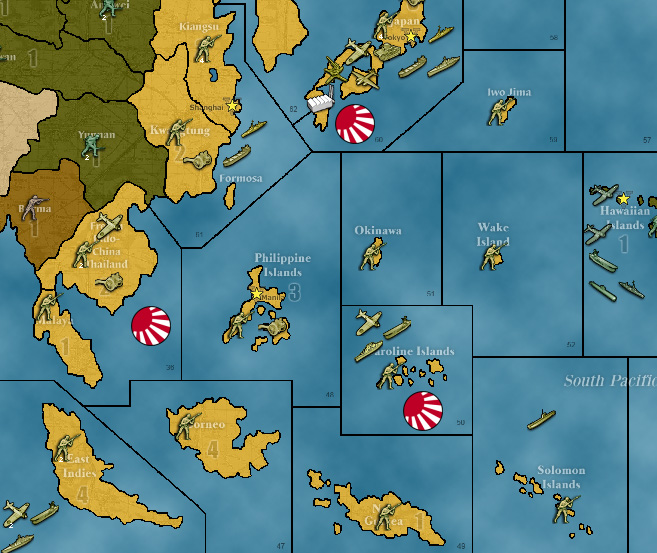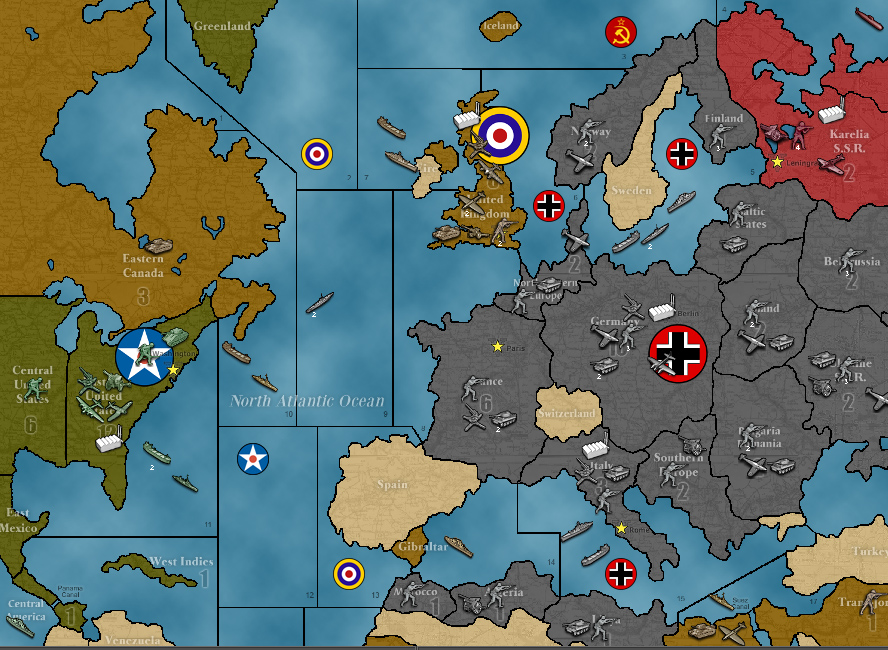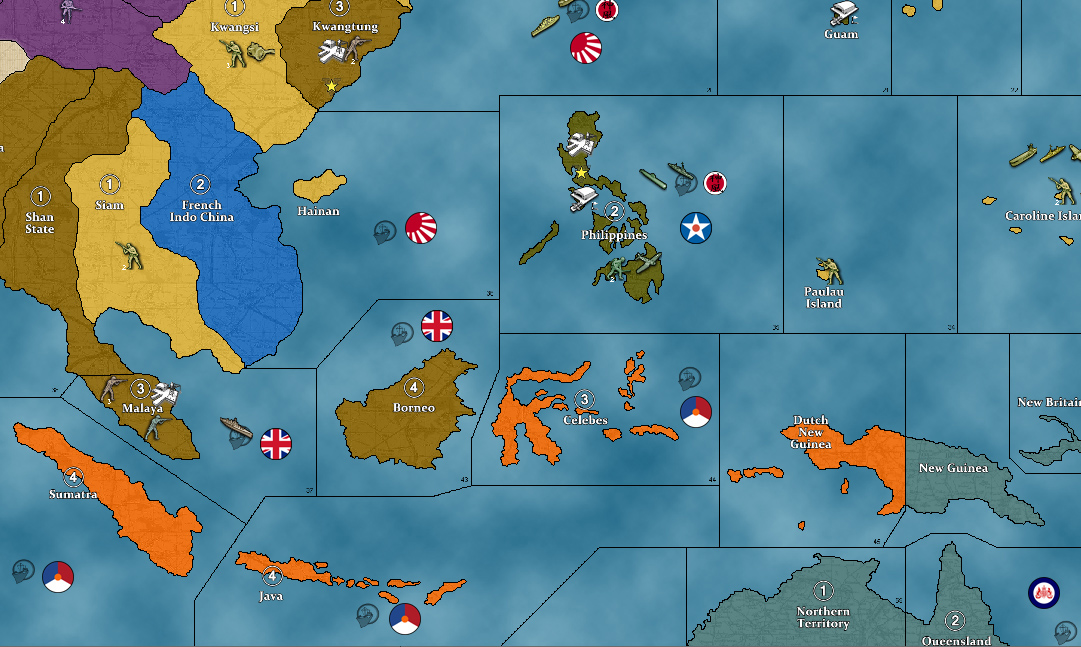@Black_Elk:
Yes I think that does a pretty good job of sumarizing my misgivings, and contrast with the OOB situation. Also important to me is the ability to create one system that could work on all game boards.
Frankly I don’t like either system, because I think the economic disruption should be a feature of the submarine unit specifically (not all warships) and that this should be a form of “attack” made during the raiding player’s own “conduct combat phase,” not during the opponent’s collect income phase!
My argument there would be for simplicity and for gameplay i.e. as a way to make the submarine different from other naval attack units, and give it a more independent “hunting role.” I say the argument is “for the gameplay” because I’m aware that historically any warship could probably disrupt convoys. But what we’re looking for in a rule, is a way to separate off the role of subs and make that role unique or advantageous when compared to other naval units at a comparable cost. More advantageous than they are in normal combat, so players actually have an incentive to use them for the economic attacks instead of just normal attacks!
Otherwise the subs just default to the same way other naval combat units work e.g. grouped together with the main fleet, or the main air group. I don’t think the submarine should work like this. (I don’t think StratBs should work like this either, for that matter, even if this conversation is just for subs, I see them as related issues. I mean the way a bomber’s economic attack advantage is subordinated to its normal combat attack advantage vs ships, instead of the other way around.)
The sub unit would be far more interesting, if it’s primary role was for economic attacks, with a secondary role in normal combat. The current situation is basically the reverse. And the sub isn’t really very unique as a convoy disrupting unit. It behaves like all other ships that disrupt convoys, except that its cheaper for the spam and can’t be hit by air without a dd.
The analogy I always return to is SBR or Rocket Attacks, I think subs should work in a similar way. Either you choose to use them as a combat unit, or you forego combat for the chance at an “economic attack.” I think you should be able to run such a “sub attack” in any coastal sea zone bordering enemy territories with an ipc value, otherwise it only works on maps with a special “marker” or map designation drawn on the sz, which means it can’t work on all game boards.
A simple rule, that took into account the max value of adjacent enemy territories, and then allowed subs to “roll” against it, would be ideal. If its overpowered, then you just build in some kind of defensive roll, similar to an AAgun vs a bomber, to destroy the sub. I used to play with similar rules in AA50 (although there it was a special roll against coastal factories for my group.)
The danger of all convoy rules that allow you to “destroy” enemy IPCs directly is how they can affect the first round purchase options. Thinking about SBR as a model, when you “raid” with a bomber in the latest games, money is removed indirectly (via the purchase/repair damage system). In the old SBR rules of Classic/Revised a successful “raid” meant that your opponent had give money to the bank immediately, with no “choice” and no damage/repair. Seems to me that the G40 convoy rules follow the earlier sort of idea of Classic or Revised (where the money is given up to the bank ie. destroyed), even though I much prefer the latter sort of idea from AA50 and later, where the player got to choose how to deal with the consequences of the raid.
In other words, I don’t think players should have to learn two totally separate “economic raiding mechanics” one for bombers and one for subs. Instead the two mechanics should mirror each other and work in similar ways. If not exactly the same, than at least similar enough that I can explain one with reference to the other.
Putting the focus on coastal factories would probably be too overpowered, given how SBR already works against these factories. But if you’re not going to put the focus on coastal factories or give the defender an intermediate “repair” type option, but use the old model (money taken goes straight to the bank) then there should at least be a chance that the “raiding” unit can be destroyed during the economic attack, the same way bombers face AA fire, defender rolls at 1 to destroy the unit attempting to raid. I think that would be way easier than separating this whole “convoy” process out across multiple turns in the game round, which is what the current G40 system does.
OK Black Elk,
I thought that my little adjustment about G40 Convoy Disruption can be enough for you, but you are really a demanding customer here. :-D
I bolded many points which you emphasis about the weakness of the actual Convoy rules or what could be a better Convoy rules.
Below, I would provide a different mechanics for Convoy Disruption but before I would address two points about how OOB G40 Convoy are still accurate toward history.
1- Warships were able to make Convoy Raid/Disruption, this imply that restricting it to Submarines is from a simplicity game perspective.
(Ex.: German’s Bismark Battleship last tour is all about Convoy Disruption gone sour.)
2- Convoy Disruption applied during Collect Income phase is not a non-sense.
Since any surviving warships units which are On Station in a Convoy SZ during this phase endure at least 2 Combat resolution phase and still be in such critical SZ, this is a kind of reward for the Sub’s owner against the enemy player which owned the surrounding TTs.
At the time when all merchant’s ships converge from across the map to provide supply to the Capital (the Collect Income), any enemy’s warships raiding Merchant’s vessels is actively blocking or destroying supply, hence Income IPCs. This part of the rule seems quite sounds to me.
Now, here is my new idea:
Keeping the general frame provided in my previous post:
@Baron:
Here is my solution to solve both:
1- attack on player’s turn (no double-dipping effect) and
2-keep record straight (no immediate plunder on IPCs already owned by player but still waiting Income Phase to apply damage).
1- All warships can do Convoy Disruption, including planes which have room to land on a Carrier. No extra Fgs or TcBs can do it, neither StBs.
2- The damage results for all warships are following their attack factor or less:
Submarines Attack @2 (or Attack @3 if playing with Super Subs Tech, or with my HR Subs A3 D1 Cost 7 or 8 IPCs)
Destroyer Attack @2
Cruiser Attack @3
Battleship Attack @4
Carrier Attack @0 (But planes which can land on Carrier do damage)
Fighter Attack @3
TcB Attack @3 or 4 (if paired to Fg)
3- During combat phase, a player can Convoy Raid an empty SZ or a SZ which have only Transports or Submarines.
Said otherwise, if any enemy’s surface warships is in the SZ, there is no Convoy Disruption, only regular combat.
(Warships are actively protecting the merchant’s ships. That’s the way to rationalize this, IMO.)
This also imply it cannot make a regular attack on Subs and/or Transport and a Convoy Raid, it is one or the other, not both.
(Same rule as with Shore Bombardment applied for Convoy Raid.)
4- When rolling for damage, you only consider the lower results which would make for a hit in regular combat.
For example, Cruiser do damage on a 3 or less: 1 is 1 IPC, 2 is 2 IPCs, 3 is 3 IPCs, 4-5-6 make no damage.
Subs do it on a 2 or less: 1 is 1 IPC, 2 is 2 IPCs, 3-4-5-6 make no damage.
5- Once all damaged are calculated, you place in SZ a number of Attacker Country Marker equal to the amount of IPCs damage.
Example, 3 US Destroyers get 1,2,3. It means 3 IPCs damage.
So you put in the SZ 3 US markers.
6- When it is the enemy’s Collect Income Phase, you substract from his IPCs income the number of his Enemy’s Control Marker in the SZ Convoy Raided up to the maximum allowed for this SZ.
7- I would give a Special Convoy Disruption for Subs, each enemy’s Submarine still present in the SZ during player’s Collect Income Phase, makes 2 IPCs additional damage, up to the maximum allowed in this SZ.
That way the OOB 2D3 Convoy damage rolls for Subs can be taken somehow into account without too much complexification.
- I will also assume my preferred type of Sub against DD:
HR SUBMARINE A3 D1 M2 C7-8 IPCs,
first strike if no enemy’s DD present,
blocked by DD on 1:1 basis sneak move and 1:1 basis submerged for a single round.
Any plane can hit unsubmerged Submarine during combat round without any Destroyer.
(If a Sub submerge during first strike phase, plane can not hit Sub.)
Convoy Raid Damage: 2 Dices keep all 1 to 3 results.
Convoy Disruption Damage On Station: Each Sub make for +2 IPCs additional damage if still present in a Convoy SZ during enemy’s Collect Income Phase.
(I believe it is needed that a zero IPCs results is possible. The sea-lanes are not enlightened as can be some Industrial Complex in a target zone. Merchant’s ships are moving while ICs are at the same place on every SBR.
The maximum damage is the same: 1d6+2 = 8 IPCs vs 2D6, 3 or less = 6 IPCs + 2 IPCs when Sub is On Station.)
DESTROYER A2 D2 M2 C7-8 IPCs,
blocks all Subs First Strike,
blocks on a 1:1 basis Sneak Move and Submerge.
Blocks on a 1:1 basis enemy’s Submarine additional +2 IPCs On Station Convoy Disruption Damage during Collect Income Phase.
-
During Combat move phase, a Submarine can choose whether to make a regular combat attack (@3 first strike, if no enemy’s DD present)
OR
to do a Convoy Raid in a given SZ.
It is only Submarine units which get this option even if the SZ is enemy controlled by warships.
Other warships (Cruiser, Carrier & planes, Battleship) can only do such Convoy Raid if there is no enemy’s Warships in the SZ to raid.
-
The Convoy Raid damage roll is determined that way: 1 roll 2D6 per Sub and keep only 1 to 3 results, and sum both dice.
It gives the amount of IPCs which will be lost during enemy’s Collect Income Phase.
You put in the SZ a Country Control Marker for each IPC damage on Convoy to keep track of the entire game round results against this Power.
There is no direct plunder on handy IPCs, only on incoming IPCs.
Other Combat units get only 1 single dice to roll, and get Convoy damage if they get their attack number or lower:
Destroyer Attack @2
Cruiser Attack @3
Battleship Attack @4
Carrier Attack @0 (But planes which can land on Carrier do damage)
Fighter Attack @3
TcB Attack @3 or 4 (if paired to Fg)
- The Merchantman’s ship Escort can retaliate as a reaction to this Sub attack (in an empty SZ or not) / Warships attack (if the SZ was empty).
This reaction is a single roll @1, nothing more, nothing less.
(Think about the fact that a defenseless military transport cost 7 IPCs which have no DD escort.
So giving a single defense roll @1 to a SZ which can worth less than 7 IPCs, is already a grim reaction defense.)
So, if more than one Submarines make such Convoy Raid (which I call a wolfpack attack), there is still only 1 defense roll @1, figurating it as Destroyer Escort defense. This imply that no more than 1 Sub can be lost at most during Convoy Raid when there is no enemy’s DD in SZ.
(Again, if there is more Subs, it is much easier to get maximum damage with less risk.)
(OPTIONAL: It can be possible IMO to add as raiders all the Tactical Bombers, not just TcBs elligible to land on a Carrier, but, after the attack, instead of a single defense roll @1, there would be an additional defense @1 against each Convoy Raiding aircraft units. It would be played as an IC’s AAA. Many Cargo Ships were equipped with AA guns and were more able to defend themselves than against Submarines attack.)
-
However, if there was any Destroyer-s in the SZ (which could be the sole survivor of a regular naval combat which occurred in the same resolve combat phase), this or these Destroyer-s can also retaliate @2 (according to OOB combat defense value) against this Submarine. And Submarine cannot sink it or them because Subs attack were focused on Merchant’s ships.
-
If the SZ was empty, this is the end of the Convoy Raid.
But, if there was any Destroyer then there is a second combat round which is like regular combat but only submarines against destroyers.
The attacking Convoy raiding Submarine can retreat after 1 round against the Destroyer, OR roll it until the destruction of one side.
That way, a Sub can make a Convoy Raid, first, and take a shot at any Destroyer protecting the SZ without being expose to counter-strike defense rolls of all other heavier warships (Cruiser, Carrier and planes or Battleship ) or defending submarines.
(This is IMO quite an interesting incentive for Subs to make economic warfare instead of a regular combat.)
-
Once all the battle in the SZ are done, if any Submarine survives until the enemy’s player Collect Income turn, then each Sub worth 2 additional IPCs Convoy Disruption damage per Sub, up to the maximum allowed according to this particular SZ.
However, any friendly or player’s Destroyer present can block this additional penalty on a 1:1 basis.
For instance, 3 DDs will block up to 3 times +2 Subs damage occurring in this SZ.
If there is more Submarine units, each worth +2 IPCs additional Convoy Disruption damage.
(IMO, this additional bonus is needed to keep an incentive ratio about cost/benefits. And 2D3 on 2D6, +2 is similar to StB damage 1D6**+2**.)
EXAMPLE:
4 Submarines and 2 Cruisers are attacking a SZ with 4 Destroyers and 1 Cruiser.
The attacking player choose to use 2 Subs on regular attack and 2 Subs on Convoy Raiding.
Always resolve Naval regular combat first:
2 Cruisers and 2 Submarines against 4 Destroyers and 1 Cruiser.
Let’s assume it goes sour for the attacker so it loose all his units and the defender keep 1 Cruiser in the SZ.
Then the 2 Submarines can do their Convoy Raid damage (22D6 keeping 1-3) against a single defense roll @1:
22D6 keeping 1-3, sums: from 0 to up to 12 IPCs.
After, Subs can either retreat or stay in the SZ, since there is only 1 enemy’s Cruiser left.
On Cruiser’s owner turn, it can attack both Subs with other reinforcement.
If there is no attacking DD, it would be Cruiser A3 against 2 Subs defending @1 with Surprise Strike.
Everything played as OOB usual.
Let’s assume that the defender choose to keep 1 Destroyer instead.
Then 2 Submarines can do their Convoy Raid damage in this first Convoy Raid round:
2*2D6 keeping 1-3, sums: from 0 to up to 12 IPCs,
against a single defense roll @1 and 1 Destroyer defending @2.
Let’s assume the Destroyer unit or the Convoy Escort get a hit.
During this first Convoy Raiding combat round, Subs can never hit Destroyers. But DDs can destroy Subs.
(I rationalize it that way: Subs are all focused on destroying Merchant’s Ship and not attacking their escorting warships.)
On the second combat round, which works like a regular attack, now.
Their is still 1 submarine remaining (attacking @3) against 1 Destroyer (defending @2).
If the Submarine survive this combat round, then it can retreat.
(Or Submerge in the SZ, according to my Sub HR. But only Sub retreat is possible according to G40 OOB.)
If it stays, then it must be a fight to the death, or can choose to retreat (or Sub submerge) anytime hereafter.
Let’s assume the Submarine retreat.
On the Destroyer’s owner turn, it can attack the Sub with any other units it can muster. As regular DD attack.
**Do you think this can be a workable balance system?
Do you see it as a sufficient incentive for Submarines Commander to prefer raiding over regular combat?**













